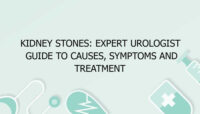A cerebral aneurysm, also known as a brain aneurysm, is a potentially life-threatening condition characterized by a bulging or ballooning of a blood vessel in the brain. This bulge can lead to serious complications, including bleeding within the brain, which can result in significant neurological damage or even death. Understanding the causes, symptoms, types, and treatments of cerebral aneurysms is crucial for early detection and effective management. This comprehensive guide aims to provide an in-depth look at cerebral aneurysms, offering valuable insights into their nature and implications.
Causes of Cerebral Aneurysm
The exact cause of cerebral aneurysms remains largely unknown, but several factors contribute to their development. The primary cause is thought to be a weakness in the blood vessel wall. This weakness can be congenital, meaning individuals are born with it, or it can develop over time due to various risk factors. Genetic predispositions play a significant role; individuals with a family history of aneurysms are at a higher risk. Additionally, certain genetic disorders such as Ehlers-Danlos syndrome, polycystic kidney disease, and Marfan syndrome are associated with an increased risk of developing cerebral aneurysms. Environmental and lifestyle factors, such as high blood pressure, smoking, and excessive alcohol consumption, can also contribute to the formation and growth of aneurysms. Conditions that lead to increased arterial pressure or damage to the vessel wall, such as trauma or infection, can further exacerbate the risk. Understanding these causes helps in identifying individuals at higher risk and implementing preventive measures.
Symptoms of Cerebral Aneurysm
Many cerebral aneurysms are asymptomatic, meaning they do not cause noticeable symptoms until they become larger or rupture. However, when symptoms do occur, they can vary depending on the aneurysm’s size, location, and whether it has ruptured. Common symptoms of an unruptured cerebral aneurysm may include headache, vision problems, pain above or behind the eye, and neurological deficits such as weakness or numbness. If the aneurysm is pressing on surrounding tissues, it may lead to issues such as difficulty with speech or balance problems. The most severe and urgent symptoms occur when a cerebral aneurysm ruptures. A rupture can cause a sudden and severe headache, often described as the “worst headache of your life,” accompanied by nausea, vomiting, stiff neck, sensitivity to light, and altered mental status or loss of consciousness. Prompt recognition of these symptoms is critical for seeking immediate medical attention to prevent serious complications.
Types of Cerebral Aneurysms
Cerebral aneurysms are classified into several types based on their shape, size, and location in the brain. Understanding these types helps guide treatment decisions and management strategies.
- Saccular Aneurysms: Also known as berry aneurysms, saccular aneurysms are the most common type. They are characterized by a sac-like protrusion from a blood vessel, typically found at branching points of the arteries in the brain. These aneurysms can vary in size and have a higher risk of rupture.
- Fusiform Aneurysms: Unlike saccular aneurysms, fusiform aneurysms involve a diffuse widening of a segment of the blood vessel rather than a distinct sac. They often occur in larger arteries and can be more challenging to treat due to their broad base.
- Dissecting Aneurysms: These aneurysms occur when a tear forms in the inner lining of a blood vessel, allowing blood to enter and separate the vessel layers. This type can lead to a narrowing of the vessel and reduced blood flow, increasing the risk of stroke.
- Mycotic Aneurysms: Mycotic aneurysms are rare and result from an infection in the blood vessel wall. Bacterial infections can lead to the formation of these aneurysms, which require antibiotic treatment in addition to addressing the aneurysm itself.
- Giant Aneurysms: Giant aneurysms are larger than 2.5 centimeters in diameter and can cause significant compression of surrounding brain tissues. Due to their size, they are more likely to cause symptoms and may require complex surgical intervention.
Treatment of Cerebral Aneurysm
Treatment for cerebral aneurysms depends on various factors, including the aneurysm’s size, location, type, and whether it has ruptured. The primary goals of treatment are to prevent rupture, manage symptoms, and address any complications.
Surgical Options: For aneurysms that pose a high risk of rupture, surgical intervention may be necessary. The two main surgical approaches are:
- Clipping: This involves placing a small metal clip at the base of the aneurysm to isolate it from the bloodstream, preventing further blood flow into the aneurysm and reducing the risk of rupture. This procedure is performed through an open craniotomy, where a portion of the skull is removed to access the aneurysm.
- Endovascular Coiling: This minimally invasive technique involves inserting a catheter through a blood vessel in the groin or arm and guiding it to the aneurysm site. Once in place, small coils are released into the aneurysm to induce clotting and block blood flow, effectively sealing off the aneurysm from the inside. This approach is less invasive than clipping and is often preferred for certain types of aneurysms.
Non-Surgical Management: In some cases, especially with small, asymptomatic aneurysms, non-surgical management may be appropriate. This approach involves regular monitoring with imaging studies to track the aneurysm’s size and growth. Lifestyle modifications, such as controlling blood pressure and avoiding smoking, are recommended to reduce the risk of aneurysm growth and rupture. Medications may be prescribed to manage related conditions or symptoms.
Management of Ruptured Aneurysms: A ruptured cerebral aneurysm is a medical emergency requiring immediate attention. Treatment typically involves emergency surgery to repair the aneurysm and manage the resulting bleeding. This may include clipping or endovascular coiling, depending on the aneurysm’s characteristics and the patient’s condition. Supportive care, such as managing increased intracranial pressure and preventing complications like vasospasm (narrowing of blood vessels), is crucial for recovery.
FAQ Section
What is a cerebral aneurysm, and how does it differ from other types of aneurysms?
A cerebral aneurysm, also known as a brain aneurysm, is a localized dilation or bulging of a blood vessel in the brain. It is a specific type of aneurysm that occurs within the cerebral circulation, as opposed to aneurysms in other parts of the body such as the aorta (aortic aneurysm) or peripheral arteries. Cerebral aneurysms can be classified based on their shape, size, and location within the brain, including saccular (berry) aneurysms, fusiform aneurysms, dissecting aneurysms, mycotic aneurysms, and giant aneurysms. Each type has distinct characteristics and implications for treatment and management. The primary concern with cerebral aneurysms is the risk of rupture, which can lead to severe bleeding within the brain and result in significant neurological damage or death.
What causes a cerebral aneurysm, and are there any known risk factors?
The exact cause of cerebral aneurysms is not fully understood, but several factors contribute to their development. A primary cause is the weakness in the blood vessel wall, which can be congenital or acquired over time. Genetic predispositions are significant, as conditions such as neurofibromatosis, Marfan syndrome, and polycystic kidney disease increase the risk of aneurysm formation. Environmental and lifestyle factors, including high blood pressure, smoking, and excessive alcohol consumption, also contribute to aneurysm development. Trauma, infections, and other conditions that affect the arterial wall may further increase the risk. Understanding these risk factors helps identify individuals at higher risk and implement preventive measures to reduce the likelihood of aneurysm formation and rupture.
What are the common symptoms of a cerebral aneurysm, and how are they detected?
Many cerebral aneurysms are asymptomatic and may not present noticeable symptoms until they grow larger or rupture. When symptoms do occur, they can vary based on the aneurysm’s size, location, and whether it has ruptured. Common symptoms of an unruptured aneurysm may include headaches, vision problems, pain above or behind the eye, and neurological deficits like weakness or numbness. If an aneurysm ruptures, it can cause a sudden, severe headache often described as the “worst headache of your life,” accompanied by nausea, vomiting, stiff neck, sensitivity to light, and altered mental status or loss of consciousness. Early detection often involves imaging studies such as magnetic resonance imaging (MRI) or computed tomography (CT) scans, which can visualize the aneurysm and guide further evaluation and treatment.
How is a cerebral aneurysm diagnosed and what tests are used?
Diagnosing a cerebral aneurysm involves a combination of medical history, neurological examination, and imaging studies. Initial evaluation includes a thorough assessment of symptoms and physical examination to identify neurological deficits. Imaging techniques such as magnetic resonance imaging (MRI) and computed tomography (CT) scans are crucial for visualizing the aneurysm’s location, size, and characteristics. MRI provides detailed images of brain structures and is particularly useful for identifying aneurysms and assessing their relationship to surrounding tissues. CT scans, including CT angiography, can quickly identify aneurysms and assess any bleeding or other complications. In some cases, additional imaging such as digital subtraction angiography (DSA) may be used for detailed visualization of the blood vessels. A definitive diagnosis may require a biopsy or further specialized imaging based on the aneurysm’s characteristics.
What are the treatment options for cerebral aneurysms, and how are they determined?
Treatment options for cerebral aneurysms depend on several factors, including
the aneurysm’s size, location, type, and whether it has ruptured. The primary goals of treatment are to prevent rupture, manage symptoms, and address any complications. For aneurysms that pose a high risk of rupture, surgical intervention may be necessary. The two main surgical approaches are clipping, which involves placing a metal clip at the aneurysm’s base to isolate it from the bloodstream, and endovascular coiling, a minimally invasive technique that involves inserting coils into the aneurysm to induce clotting and seal it off. Non-surgical management may be appropriate for small, asymptomatic aneurysms and involves regular monitoring with imaging studies, lifestyle modifications, and medications to manage related conditions. The choice of treatment is determined based on the aneurysm’s characteristics, patient health, and other factors that affect the risk and potential outcomes of intervention.
How long does recovery take after treatment for a cerebral aneurysm?
Recovery time after treatment for a cerebral aneurysm varies based on the type of treatment, aneurysm characteristics, and individual patient factors. For surgical interventions such as clipping, recovery typically involves a hospital stay followed by a period of rest and rehabilitation, which can range from weeks to months. The recovery process includes managing surgical wounds, monitoring for complications, and undergoing physical or occupational therapy to address any deficits. Endovascular coiling is less invasive, and recovery time is generally shorter, with many patients resuming normal activities within a few weeks. However, individuals may still require follow-up care and monitoring to assess treatment effectiveness and manage any residual symptoms. The overall recovery process involves managing treatment-related side effects, rehabilitation, and ongoing medical care to support long-term health and well-being.
Can cerebral aneurysms be prevented, and what are the best practices for reducing risk?
Preventing cerebral aneurysms is challenging due to the complex interplay of genetic and environmental factors. While it is not always possible to prevent aneurysms, certain practices can help reduce the risk. Managing high blood pressure through lifestyle changes and medication is crucial, as elevated blood pressure can contribute to aneurysm formation and growth. Avoiding smoking and excessive alcohol consumption also helps reduce risk, as these factors can damage blood vessels and increase the likelihood of aneurysm development. For individuals with a family history of aneurysms or genetic conditions associated with aneurysm risk, regular medical check-ups and imaging studies may be recommended for early detection and monitoring. Genetic counseling and testing can provide valuable information for individuals at higher risk and guide preventive strategies. Adopting a healthy lifestyle and addressing risk factors can contribute to overall vascular health and reduce the likelihood of aneurysm-related complications.
What is the prognosis for individuals with cerebral aneurysms?
The prognosis for individuals with cerebral aneurysms depends on several factors, including the aneurysm’s size, type, location, and whether it has ruptured. Benign, unruptured aneurysms that are detected early and managed appropriately typically have a favorable prognosis, with many individuals leading normal lives after treatment. The prognosis for ruptured aneurysms is more complex and depends on the severity of the rupture, the extent of bleeding, and the effectiveness of treatment. Immediate medical attention and prompt treatment are crucial for improving outcomes and minimizing neurological damage. Advances in treatment options, including minimally invasive techniques and supportive care, have improved prognosis for many patients. Regular follow-up care, monitoring, and rehabilitation are essential for assessing recovery, managing any residual effects, and supporting long-term health and quality of life.
How does a cerebral aneurysm affect daily life, and what support is available?
A cerebral aneurysm can significantly impact daily life, particularly if it leads to symptoms or complications such as headaches, neurological deficits, or cognitive changes. Individuals with unruptured aneurysms may experience anxiety or stress related to the risk of rupture, which can affect their overall well-being. For those who have experienced a rupture or undergone treatment, recovery may involve adjustments to daily activities, including rehabilitation for physical or cognitive impairments. Support is available through medical care, rehabilitation services, and counseling. Healthcare providers can offer guidance on managing symptoms, addressing treatment-related side effects, and implementing lifestyle changes to support recovery. Support groups and resources for individuals and families affected by cerebral aneurysms can provide valuable emotional and practical support. Engaging in a comprehensive care plan, including medical treatment and support services, can help individuals navigate the challenges of living with a cerebral aneurysm and improve their quality of life.


